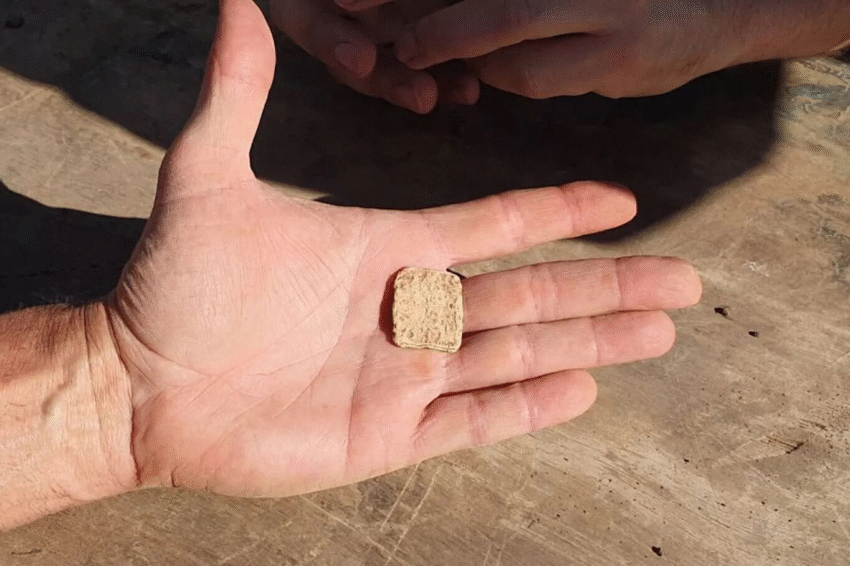It seems the Mount Ebal curse tablet that was found back in 2019 has generated some controversy:
In January 2022, we became aware that this discovery was in the pipeline and would be released to the public via a peer-reviewed journal sometime around the end of summer that year. Barely two months later, the world of biblical archaeology exploded with news of the artifact, released at a press conference in Texas. (Apparently, some unsavory circumstances had necessitated the sudden, early release of the discovery to the general public.)
The announcement, in short, was the discovery at Mount Ebal (the biblical, conquest-period “mountain of curse”) of a miniature folded lead defixio (curse tablet), inscribed both inside and out with curse text. The item had been discovered in 2019, while Dr. Scott Stripling and his Associates of Biblical Research (abr) team wet-sifted the excavation dumps of Prof. Adam Zertal’s 1980s dig at the site of “Joshua’s Altar.” The item proved too fragile to unfold, so it had been sent to a specialist laboratory in Prague to undergo tomographic scans in an attempt to read the interior. The lead object was announced at the press release as containing the following inscription: “Cursed, cursed, cursed—cursed by the God yhw; You will die cursed; Cursed you will surely die; Cursed by yhw—cursed, cursed, cursed.” It was further noted that the item had been discovered among other Late Bronze/Early Iron Age material and faunal remains at the site, thus collectively befitting the biblical account of “cursing” at the altar (i.e. Deuteronomy 11:29; Joshua 8:30-31).
Unfortunately, little to no imagery of the item was shown at the press release; interested parties eagerly anticipated the eventual release of the discovery via a peer-reviewed journal.
We initially reported on the discovery the same day. That same month, our Let the Stones Speak magazine featured Mount Ebal, the Israelite conquest period, and the original work of the late Professor Zertal. Our Let the Stones Speak podcast host Brent Nagtegaal conducted two interviews with Dr. Stripling on the subject (here and here), and a general summary program on the subject. Based on additional information highlighted in one of Stripling’s interviews, we published another article.
In the months following the release, a significant level of pushback developed in the archaeological community, primarily regarding the manner of initial announcement (via press release to the public, prior to the peer-reviewed publication), as well as the lack of supplied pictures or scans of the otherwise-sensational curse text. Haaretz took things to the nth degree, bringing forward accusations of illegality in its controversially-titled piece: “From West Bank Debris to Evangelical Hands: The Shady Journey of a Bible-Era Curse.” The article charged that the artifact had been removed illegally from an area of Palestinian control and had further been wrongfully taken outside of the country to Prague. We noted these and other criticisms in another article.
The official peer-reviewed article for the discovery was finally published in May last year. This article largely focused on the reading for the interior of the tablet, including images of the tomographic scans. (The peer-reviewed article for the outer reading is still forthcoming.) This article also included the archaeological context of the discovery—particularly, the Late Bronze/Early Iron Age context, including ceramics and faunal remains excavated from the site.
Following the publication of the peer-reviewed article, a number of different takes from various scholars and enthusiasts appeared. Some were positive, some neutral, but many negative, complaining that the scans of the interior of the artifact did not show discernible letters, but instead, merely dents and striations. Further, the variable-sized “letters” and veritable spaghetti-direction of text necessary to produce such a reading were also criticized as entirely illogical. source: https://armstronginstitute.org/993-latest-round-in-mount-ebal-saga-curse-tablet-hit-by-one-two-three-punch-but-is-it-a-knockout
The skepticism did not stop there, with one place referring to the find as only a “lead fishing weight” and nothing more.
The article moves on, however, and wryly makes some strong observations:
In all this, I tend to generally agree with Michael Banyai’s featured comment on Kletter’s article (an article that drew conclusions along similar lines to Maeir’s and Rollston’s), posted to The Bible and Interpretation. He wrote:
“I partially agree with your insight, and as I stated, I would have discouraged any attempt to read something on the lead strip. Otherwise, as a matter of fact, without dealing with the text proper, but with the fact of a lead strip and its finding context [Mount Ebal], one must point at a widespread ancient tradition of lead curse spells, both Greek and Jewish, going back to an original Late Bronze Age Luwian tradition …. Therefore, the identification of the lead strip as a curse is most natural. I wouldn’t like to make myself a laughingstock assuming this to be a fishing weight lost on the arid summit of Mount Ebal. The reading is, however, unverifiable.” source: ibid
What appears to be not mentioned, however, in any case is that a curse tablet that meanders around in a seemingly drunken, chaotic way, WAS a curse as far as Israel was concerned. After all, why would anyone carry a lead fishing weight to a mountain? It certainly isn’t because the fish are biting well.

